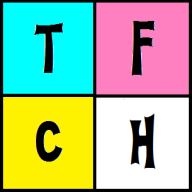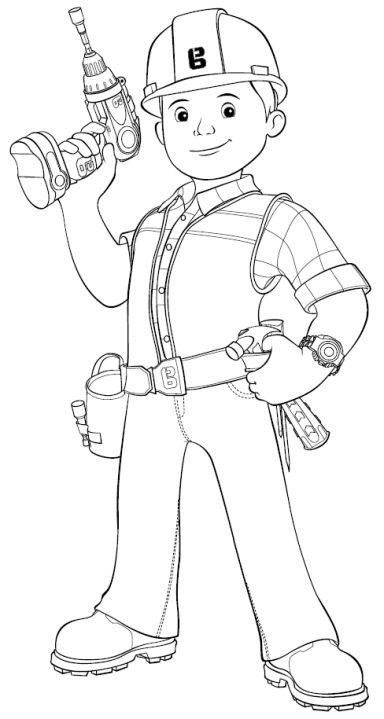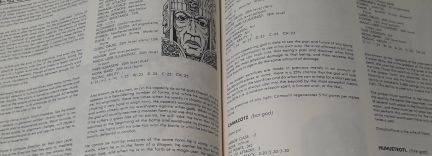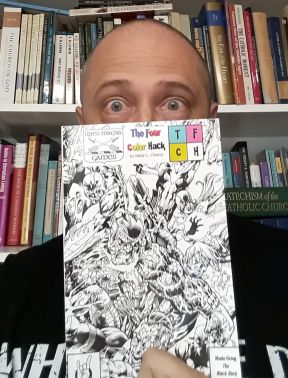
Spes Magna Games has been in business since December 2009. In that time, I’ve published more than 50 PDFs for various game systems. About two years ago, I released The Four Color Hack. At the time, I had vague plans of eventually releasing TFCH as a print-on-demand game.
Well, eventually has arrived, and TFCH is officially Spes Magna’s first real book.
You can get TFCH as a 6-by-9-inch 80-page black-and-white softcover for $10.95 (not including shipping and handling). The softcover includes the $3 PDF. If you’ve not checked out TFCH yet, start with the PDF. If you like what you see, and you want the book, use this link right here to get the print-on-demand version for $7.95. Caveat: The discount link in the previous sentence expires at the end of September 2018.
Ms. Jessica Dow deserves a big “Thanks!” for picking up the dropped ball of formatting TFCH for print-on-demand. I hope to work with Ms. Dow again on another print-on-demand job in the near future.
But enough of that. Let’s head back into the Chinese Mythos from the AD&D Deities & Demigods. Today, we meet Mu Yuan, the 70-foot-tall killer of the gods, for use with 5E D&D.
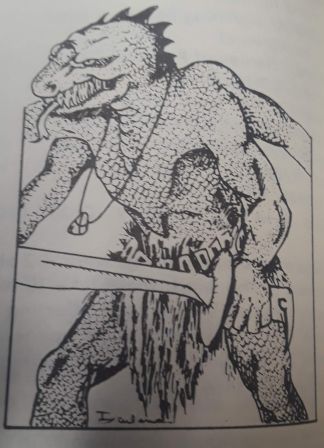
This monster has 3 eyes in his tyrannosaurus-shaped head, and has 4 large humanoid arms. He has the strength of a storm giant…. He also has a powerful magical device shaped in the form of a small triangular piece of stone that has the power to turn into any weapon [Ma Yuan] wishes, magical or otherwise. (Deities & Demigods, page 40)
Ma Yuan
Gargantuan monstrosity, chaotic evil
Armor Class 24 (natural armor)
Hit Points 615 (30d20+270)
Speed 60 ft., fly 60 ft., swim 60 ft.
Ability Scores STR 29 (+9), DEX 10 (+0), CON 28 (+9), INT 13 (+1), WIS 14 (+2), CHA 13 (+1)
Saving Throws INT +9, WIS +10, CHA +9
Skills Religion +9
Damage Resistances fire (due to Morphic Stone); bludgeoning, piercing, and slashing from non-legendary attacks
Damage Immunities bludgeoning, piercing, and slashing from nonmagical attacks
Senses passive Perception 12
Languages Abyssal
Challenge 28 (120,000 XP)
Amphibious. Ma Yuan can breathe water and air.
Frightful Presence. Each creature of Ma Yuan’s choice that is within 120 feet of him and aware of him must succeed on a DC 22 Wisdom saving throw or become frightened for 1 minute. A creature can repeat the saving throw at the end of each of its turns, ending the effect on itself on a success. If a creature’s saving throw is successful or the effect ends for it, the creature is immune to Ma Yuan’s Frightful Presence for the next 24 hours.
Legendary Resistance (3/Day). If Ma Yuan fails a saving throw, he can choose to succeed instead.
Magic Resistance. Ma Yuan has advantage on saving throws against spells and other magical effects.
Magical Weapons. Ma Yuan’s weapon attacks are magical.
Siege Monster. Ma Yuan deals double damage to objects and structures.
Actions
Multiattack. Ma Yuan can use his Frightful Presence. He then makes up to five attacks: one with his bite and four with his claws. He can make a Morphic Stone attack in place of one or two claw attacks, depending on whether the Morphic Stone takes the form of a one-handed weapon or a two-handed weapon.
Bite. Melee Weapon Attack: +17 to hit, reach 10 ft., one target. Hit: 48 (6d12+9) piercing damage. If the target is a Large or smaller creature, it is grappled (escape DC 22). Until this grapple ends, the target is restrained, and Ma Yuan can’t bite another target.
Claw. Melee Weapon Attack: +17 to hit, reach 15 ft., one target. Hit: 22 (3d8+9) slashing damage.
Morphic Stone. Melee Weapon Attack: +17 to hit, reach 15 ft., one target. Hit: 37 (8d6+9) slashing damage plus 14 (4d6) cold damage. As an action, Ma Yuan can transform the Morphic Stone into any melee weapon, magical or otherwise, that he wants to wield. Quadruple the weapon’s damage dice since Ma Yuan is Gargantuan. The preceding attack and damage values reflect Ma Yuan using a Gargantuan greatsword frost brand.
Legendary Actions
Ma Yuan can take 3 legendary actions, choosing from the options below. Only one legendary option can be used at time and only at the end of another creature’s turn. Ma Yuan regains spent legendary actions at the start of his turn.
Change Morphic Stone. Ma Yuan can change the Morphic Stone into a different melee weapon and then attack with that weapon.
Move. Ma Yuan moves up to half his speed.
Swallow (Costs 2 Actions). Ma Yuan makes one bite attack against a Large or smaller creature it is grappling. If the attack hits, the target takes the bite’s damage, the target is swallowed, and the grapple ends. While swallowed, the creature is blinded and restrained, it has total cover against attacks and other effects outside Ma Yuan, and it takes 49 (14d6) acid damage at the start of each of Ma Yuan’s turns.
If Ma Yuan takes 60 damage or more on a single turn from a creature inside it, Ma Yuan must succeed on a DC 20 Constitution saving throw at the end of that turn or regurgitate all swallowed creatures, which fall prone in a space within 10 feet of Ma Yuan. If Ma Yuan dies, a swallowed creature is no longer restrained by it and can escape from the corpse by using 30 feet of movement, exiting prone.
Tags: 5E D&D, Deities & Demigods, monsters, TFCH
